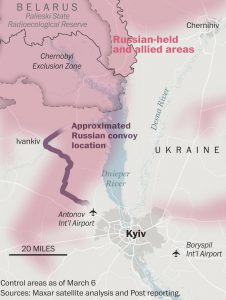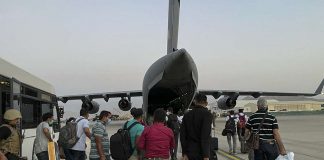MARCH 7, 2022

KYIV, Ukraine — Makeshift roadblocks have been installed throughout this capital to impede the movements of Russian troops snaking toward the city in a convoy about 15 miles away.
On some strategic thruways, Ukrainians have parked trams and buses to restrict driving access. Checkpoints to inspect IDs have also been established to root out would-be saboteurs. “We have a lot of presents” for the Russians, Kyiv Mayor Vitali Klitschko said in an interview. “It’s not sweetie. It’s very painful.”
The extended 40-mile parade of Russian armored vehicles, tanks and towed artillery headed from the north on a path toward Kyiv has both alarmed and befuddled watchers of this expanding war. It’s not just its sheer size. It’s also because that for days, it has not appreciably been moving.
U.S. officials attribute the apparent stall in part to logistical failures on the Russian side, including as a result of food and fuel shortages, that have slowed Moscow’s advance through various parts of the country. They have also credited Ukrainian efforts to attack selected parts of the convoy with contributing to its slowdown. Still, officials warn that the Russians could regroup at any moment and continue to press forward.
In Kyiv, the approaching convoy has mustered much more inspiration than fear, motivating residents to exact revenge on the Russian invasion in any way they can.
“The target in Ukraine is not secret. The target is capital of Ukraine,” Klitschko said.
Russian troop movements from the north pose a risk, he acknowledged. “And we prepare to give the answer,” he said.
In northern Kyiv, soldiers and volunteers have dug trenches and set up positions and equipment — including an antiaircraft gun — to prepare for the potential arrival of Russian troops in the capital. Nearly every business in the city, except for certain grocery stores, gas stations and pharmacies, have closed. With schools and offices shuttered, residents have largely either fled or joined the resistance.
While U.S. officials say the convoy is designed to replenish and re-equip Russian forces, they acknowledge it is still possible that certain elements could be intended to help the attack.
“Our assessment is that it’s largely meant for resupply — but I can’t rule out that there aren’t combat vehicles,” Pentagon spokesman John Kirby said Monday. “We can’t even say that it’s all one convoy and not several.”
Still, the convoy’s progress — or lack thereof — continues to capture popular fascination, thanks to a steady stream of satellite images and video recorded and disseminated by Maxar Technologies, a space technology and intelligence company.
The images have put the business of tracking Russian supply lines, normally the occupation of secretive government agencies, into the public sphere, making them staples of TV news broadcasts and inspiring armchair generals around the world to offer their advice on how to attack the column. The massive lineup of military vehicles — sometimes positioned two or three side-by-side on the road, sometimes spaced by several yards — appears both formidable and foreboding.
While fuel and ammunition transport vehicles tend to stick out, they can be camouflaged, said Michael Kofman, director of Russian studies at CNA and an expert on the Russian military.
The British defense ministry’s warnings support U.S. officials’ assessment that Russia is trying to correct course to overcome logistical challenges, but it also provides more potential targets for Ukrainians trying to handicap the Russian war effort.
Fuel trucks are exactly the sort of “soft targets” that the Ukrainians should be aiming to attack as they attempt to undermine the more sizable and powerful Russian army’s ability to fight, according to Rep. Jason Crow (D-Colo.), an Army veteran who fought in Afghanistan and Iraq and visited Ukraine in recent weeks.
“You don’t hit the combat units. You don’t hit the tanks. You hit the fuel trucks, the ammunition trucks,” Crow said. “You cut off their supplies, and you also try to strike terror into the minds of the enemy.”
The sight of the stretch of Russian vehicles appears to be helping bolster public opinion toward providing more military aid. Government officials, once reluctant to escalate involvement in the conflict, are now talking about providing aircraft and additional munitions to help Ukraine resist the ongoing invasion.
“I call that 40-mile convoy, by the way, the biggest, fattest target in Ukraine,” retired Navy admiral James Stavridis, who previously led NATO forces as the Supreme Allied Commander Europe, said on MSNBC. Put certain fighter jets “in the hands of the Ukrainians,” he added, “and watch that thing blow up.”
The question of whether to equip Ukraine with enhanced air power has gripped NATO allies over the last week, after an initial plan for European nations to send fighter jets to Ukraine formed but then appeared to fall apart, under Russian threats to mete out “consequences” for countries materially assisting the Ukrainian resistance.
Over the weekend, Ukrainian President Volodymyr Zelensky made impassioned appeals to world leaders and directly to members of Congress for planes and drones to hold off the Russian advance. Now, there are potential plans under discussion in which the United States could help facilitate Poland sending MiG-29 planes to Ukraine by backfilling the Polish fleet.
On Sunday, Secretary of State Antony Blinken said the United States was “very, very actively” working toward such a plan.
That stands in contrast to the administration’s demonstrated resistance to calls for establishing a no-fly zone over Ukraine, which would almost certainly require direct engagement with Russian air forces. President Biden has repeatedly stated that no U.S. troops would be deployed to Ukraine.
U.S. officials have similarly ignored calls from lawmakers to supply attack aircraft to Ukraine directly. A push to send Ukraine, A-10 Warthogs, for example, has gone nowhere, in part because most Ukrainian military pilots are not trained on them.
The country’s forces are more familiar with how to operate, maintain and repair the Soviet-era MiG fighters potentially on offer from Poland, to give them more muscle as they battle the Russians for control of the airspace over key spots, like the convoy.
“More than likely, Russian forces have local air superiority, so it’s doubtful Ukrainian forces have good opportunity to strike,” Kofman said of Kyiv’s current posture. Given that imbalance, he added, “the Ukrainians’ best chance” of damaging the convoy at this point “is with drones.”
Ukraine has had some success striking Russia targets with Bayraktar TB2 drones, which were purchased from Turkey. Last week, Ukraine’s defense minister said in a Facebook post that additional Bayraktar drones had just arrived in the country, but it is unclear how many more drones Kyiv had bought.
Tony Radakin, the head of the United Kingdom’s armed forces, said during an interview with the BBC on Sunday that the Ukrainian attacks on the convoy are “impacting on morale” among Russian troops. Some of those troops are camping out in the nearby forest, Radakin added, for fear of staying in convoy vehicles that might be struck.
It remains to be seen if Ukraine will be able to cause enough damage to the convoy and other Russian supply lines to hold back the Russian advance — and whether their efforts will be fast enough to change the course of the fight.
As the Russian ground advance hit snags, its efforts to bombard Ukrainian cities appear to be intensifying. In recent days, Russia has been “increasing its use of long-range firepower to supplement or to make up for the lack of ground movement,” a senior defense official said Monday, who spoke on the condition of anonymity under terms established by the Pentagon. Civilians are also being hit as they attempt to flee, the official added.
The U.N. high commissioner for refugees estimated Sunday that more than 1.5 million people living in Ukraine have fled since the Russian invasion began, making it “the fastest growing refugee crisis since World War II.”
Despite the courage and motivation to fight the incoming convoy, Kyiv residents have also watched in desperation the shelling and cutoff escape routes in cities elsewhere.
Although residents are gearing up for the approaching convoy, they know they soon might not have the chance to get out as more roads are overtaken by the Russians. On Monday evening, the central train station in Kyiv was packed with families escaping the capital, many carrying their dogs and cats as they crammed into crowded trains headed west.
Courtesy/Source: WPost










































































































